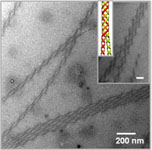
Polymers having “conjugated structures”,
allowing them to conduct electricity, hold great potential for flexible and
ink-jet printable electronic devices
and inexpensive plastic solar cells. Work
by Hayward and Emrick
in the Materials Research Science and Engineering Center (MRSEC) on Polymers at
the University of Massachusetts Amherst has shown how to coax such polymers to
twist into conducting wires thousands of times smaller than the twisted cables
used in common electronic devices. These structures are based on polythiophenes, which tend to crystallize into ribbons
only a few nanometers in thickness. Such crystalline nanostructures are
important to determining the electronic properties of materials based on this
polymer, and the ability to control their formation holds promise for improving
the performance of devices. Remarkably, the inclusion of functional groups that
bind salt ions leads to twisting of these nanowires into helices that join
together into double helices, reminiscent of DNA, and larger bundles containing
multiple strands. These materials provide opportunities to 1) study the still
poorly understood driving forces for helical assembly, and 2) tune the
electronic properties of conjugated polymers.